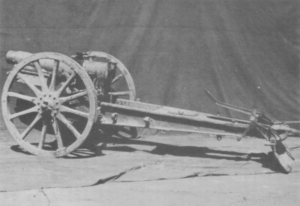Type 38 12 cm Howitzer
| Japanese Type 38 12 cm Howitzer | |
|---|---|
|
Japanese Type 38 120mm Howitzer | |
| Place of origin | Empire of Japan |
| Service history | |
| In service | 1905-1945? |
| Used by |
|
| Wars | World War II |
| Specifications | |
| Weight | 2,164.5 kg (4,772 lb) |
| Length | 4.90 m (16 ft 1 in) |
| Barrel length | 1.32 m (4 ft 4 in) |
|
| |
| Caliber | 120 mm (4.72 in) |
| Action | Manual |
| Breech | Interrupted thread |
| Recoil | Hydro spring |
| Elevation | -5° to +43° |
| Traverse | -2° to +2° |
| Muzzle velocity | 276 metres per second (910 ft/s) |
The Type 38 12 cm Howitzer (1905) is an obsolete Japanese field piece used by the Imperial Japanese Army during the Second Sino-Japanese War and World War II. It was encountered by Allied forces for the first time on Iwo Jima, and it may be used again as an emergency or substitute weapon. The Type 38 designation was given to this gun as it was accepted in the 38th year of Emperor Meiji's reign (1905).[1]
Description
It is characterized by a very short barrel, box trail, and large wooden wheels. It has an interrupted thread type breech block and hydro-spring recoil-mechanism. No shield is used with this weapon.[2]
Elevating and transversing hand wheels, and panoramic sight are at the left of the breech. The firing mechanism is a lanyard actuated percussion type.[2]
Armor-piercing high-explosive (APHE) and shrapnel shells have been recovered. Both projectiles have the usual color markings and are similar in appearance to 75mm APHE and shrapnel shells. The APHE shell weighs 44 pounds; the shrapnel shell contains 300 lead balls.[2]
References
Notes
- ↑ War Department Special Series No 25 Japanese Field Artillery October 1944
- 1 2 3 "Japanese Artillery Weapons, CINPAC-CINPOA Bulletin 152 45". US War Department. 1 July 1945.
Bibliography
- US War Department Japanese Artillery Weapons, CINPAC-CINPOA Bulletin 152 45" 1 July 1945
- War Department Special Series No 25 Japanese Field Artillery October 1944
External links
![]() Media related to Type38 12cm Howitzer at Wikimedia Commons
Media related to Type38 12cm Howitzer at Wikimedia Commons
